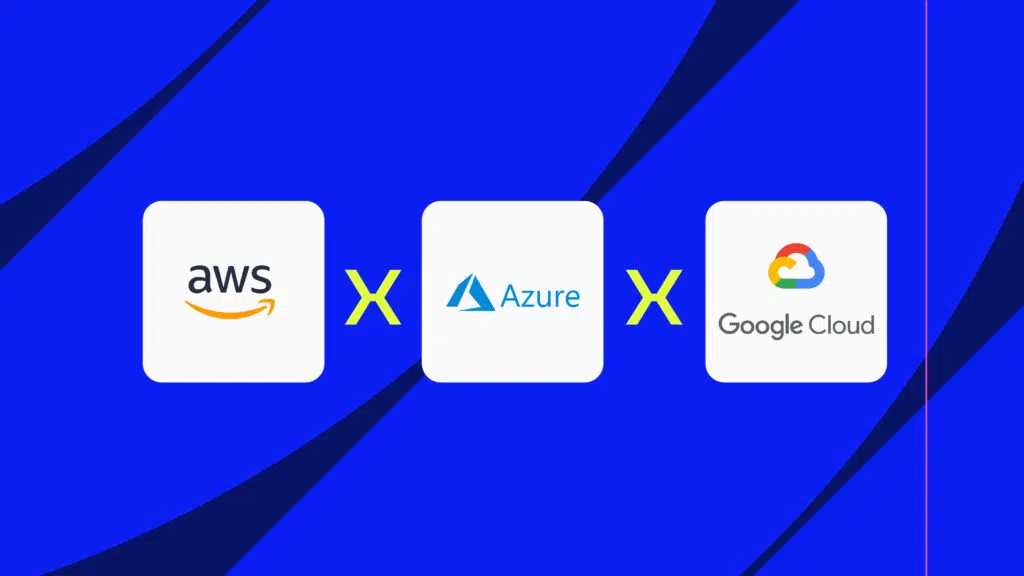Migrating to the cloud is a significant step for many organizations looking to improve efficiency, scalability and innovation in their IT operations.
According to data from Forbes , the number of large organizations with a multicloud (i.e. purchasing cloud services from more than one provider) is expected to increase from 76% to 85% during 2024.
In this era of cloud computing, where flexibility, scalability and efficiency are the watchwords for companies of all sizes, one of the crucial decisions organizations face when migrating to the cloud is choosing the ideal service model : Infrastructure as a Service (IaaS), Platform as a Service (PaaS) or Software as a Service (SaaS).
This choice not only determines the level of control and responsibility the company will have over its infrastructure and applications, but also has a significant impact on its operational agility and ability to innovate.
Therefore, in this article, we will deeply explore the three cloud service models, highlighting their distinct features, benefits, and challenges. By the end of reading, we hope you are well-equipped to make an informed decision about which model best aligns with your organization's unique needs and goals!
Good reading!
Migration to the cloud: how important is it to choose the right model?
Choosing the cloud migration model is essential for IT infrastructure capabilities Each model – whether infrastructure as a service ( IaaS ), platform as a service (PaaS) or software as a service (SaaS) – offers different levels of control, flexibility and management.
For example, IaaS allows almost complete control over hardware , ideal for companies that need a highly customizable solution, while PaaS offers an environment for developing and deploying applications without the complexity of managing hardware . SaaS, in turn, delivers complete applications managed by the provider.
Therefore, choosing the inappropriate model when migrating to the cloud can result in unnecessary expenses , operational complexity and even technical limitations that prevent the company from achieving its objectives.
Furthermore, the choice of cloud migration model has direct implications for security, compliance and data governance. Privacy and data protection regulations, such as the LGPD , require companies to be meticulous in how and where data is stored and processed.
Given this scenario, each company must evaluate its need for customization, control and available budget for migration to the cloud, analyzing which service model — IaaS, PaaS or SaaS — will best meet its business objectives and technical requirements.
IaaS, PaaS and SaaS: understand the difference between them
- IaaS (Infrastructure as a Service) : offers a virtualized computing
infrastructure In this model, companies have the flexibility to manage their environments and choose resources as needed, which can result in cost reduction, as they only pay for what they use; - PaaS (Platform as a Service): provides an environment for developing and deploying applications without the need to manage the underlying infrastructure.
This allows developers to focus on code and innovation without worrying about managing servers, storage, or networking; - SaaS ( Software as a Service) software distribution model where services are accessed via the internet. An outsourced provider manages infrastructure and operational platforms, freeing customers from software , which simplifies operations and reduces IT costs.
See below for details about each of these models, and how they apply in the day-to-day lives of companies.
IaaS: flexible infrastructure in the cloud
As we've seen, IaaS, or infrastructure as a service , provides an on-demand cloud environment, offering flexibility and scalability for varied workloads with simplified resource management.
Examples of IaaS providers
Top IaaS providers include Amazon Web Services (AWS) , which offers services such as Amazon EC2, which allows users to run virtual server instances; Microsoft Azure , which in addition to PaaS, also offers IaaS services, such as virtual machines and virtual networks; and Google Cloud Platform (GCP) , which provides resources like Google Compute Engine that are equivalent to physical servers.
Advantages of choosing IaaS
Choosing IaaS brings numerous advantages, such as:
- Flexibility: adapt the infrastructure to the needs of real-time applications;
- Cost: pay only for the resources consumed, without the initial investment in physical infrastructure;
- Scalability: increase or decrease resources according to demand to deal with spikes and drops in usage;
- Focus on the business: with the infrastructure managed by the provider, companies can direct more attention to the core business .
Use cases
IaaS is ideal for a variety of use cases, including machine learning workloads , which allow you to leverage advanced computing resources to train and deploy models; and IoT , which offers the management and analysis of large volumes of data generated by connected devices.
Furthermore, the IaaS model is also used in storage and backup , allowing the archiving of corporate data with security and accessibility.
PaaS: Simplifying Application Development
Platform as a Service (PaaS) has transformed the way organizations build and deploy applications in the cloud. Offering a complete environment for application development and management, it allows companies to focus on innovation while the technical aspects are managed by the platform.
Examples of PaaS providers
Top PaaS providers include Heroku , a platform that allows developers to build, run, and operate applications entirely in the cloud; Google App Engine , which allows you to build highly scalable applications on a fully managed platform; and Microsoft Azure App Service , which provides a hosting environment for building web and mobile applications.
Advantages of choosing PaaS
Selecting a PaaS brings notable advantages for application development, notably:
- operational and infrastructure costs software are provided by the platform;
- Increase in application delivery speed due to simplification of the development process;
- Access to a set of modern tools and services that promote innovation and improve application performance.
Use cases
Companies that intend to scale their applications quickly tend to benefit from PaaS. One example is use in development and testing environments , providing a consistent and isolated work area. Additionally, PaaS supports data-driven development and microservices, ideal for companies looking to modernize their application architectures.
SaaS: turnkey software
Finally, SaaS , or software as a service, refers to cloud solutions that allow users to access and use software directly via the internet . Thus, this model eliminates the need for complex installations and infrastructure management.
Examples of SaaS providers
Some examples of SaaS providers include Google Workspace (formerly G Suite), with Gmail, Docs, Drive, Calendar, and other productivity services; Microsoft 365, which includes Microsoft Office and other cloud-based productivity services; and Salesforce , a leading customer relationship management (CRM) platform that offers a variety of business applications focused on sales, customer service, marketing and more.
Advantages of choosing SaaS
Choosing SaaS brings some advantages, including:
- Cost savings: SaaS eliminates the need for significant upfront investments in hardware and software . Customers pay for a subscription to the service, which can help reduce operating and capital costs;
- Ease of installation and maintenance: as the software is hosted in the cloud, there is no need to install it on users' devices. Additionally, the SaaS provider is responsible for software ;
- Remote access and mobility: Users can access SaaS applications from anywhere with an internet connection, which is ideal for companies with remote teams or who need mobile access.
Use cases
SaaS applications are ideal for team collaboration , customer relationship management (CRM), enterprise resource planning (ERP), and many others. Therefore, businesses of all sizes benefit from adopting SaaS cloud solutions to improve productivity and make the management of their resources more flexible.
After all, how to choose the right model when migrating to the cloud?
To make the correct decision between IaaS, PaaS and SaaS when migrating to the cloud, it is important for companies to evaluate the total cost of ownership, ease of use, scalability and security that each model offers.
It is also important to take into account the technological maturity of each organization and the IT team's ability to manage the chosen solution. Companies that prefer to focus on their core business and avoid IT staff expenses, for example, may benefit more from SaaS, while those with robust IT teams and specific customization needs may prefer IaaS or PaaS.
To help your business evaluate this decision when migrating to the cloud, we have prepared a comparative table. Check out:
| Aspect | IaaS | PaaS | SaaS |
| Workloads | For businesses that need control over their environment but want to avoid maintaining physical hardware | For developers who want to create applications without worrying about infrastructure management | For companies looking for ready-to-use solutions , without the need for development or hosting |
| Migration strategy | Requires a detailed assessment of existing infrastructure and careful planning for the transition | Simplifies application migration with automatic management of environments and middleware | Involves data transfer service configuration |
| Company size | Scalable to serve small to large organizations, depending on the service provider | Typically targeted at medium to large that require robust development environments | Flexible for all business scales , with adjustable plans according to demand growth |
| Safety | Extremely customizable | provider-managed level of security , with some customization options | Security is managed entirely by the vendor , with established compliance and protocols |
Move to the cloud with Skyone
Our platform offers complete cloud computing solutions, including Autosky , which performs your migration to the cloud efficiently and securely within hours . From this transformation, your IT spending savings can be up to 70%!
Our team of experts takes care of everything so that your migration to the cloud is successful – and you have the opportunity to focus on what matters most: your business.
Come find out how we can boost your journey to cloud success!
Conclusion
As we have seen throughout this article, migration to the cloud represents a significant transformation in business processes, encouraging innovation and ensuring greater scalability.
Additionally, it is critical to understand that this transition can involve a variety of environments, including private cloud, hybrid cloud, and other configurations, each serving specific business needs.
Continue your journey of knowledge by checking out our complete guide on migrating to the cloud!




